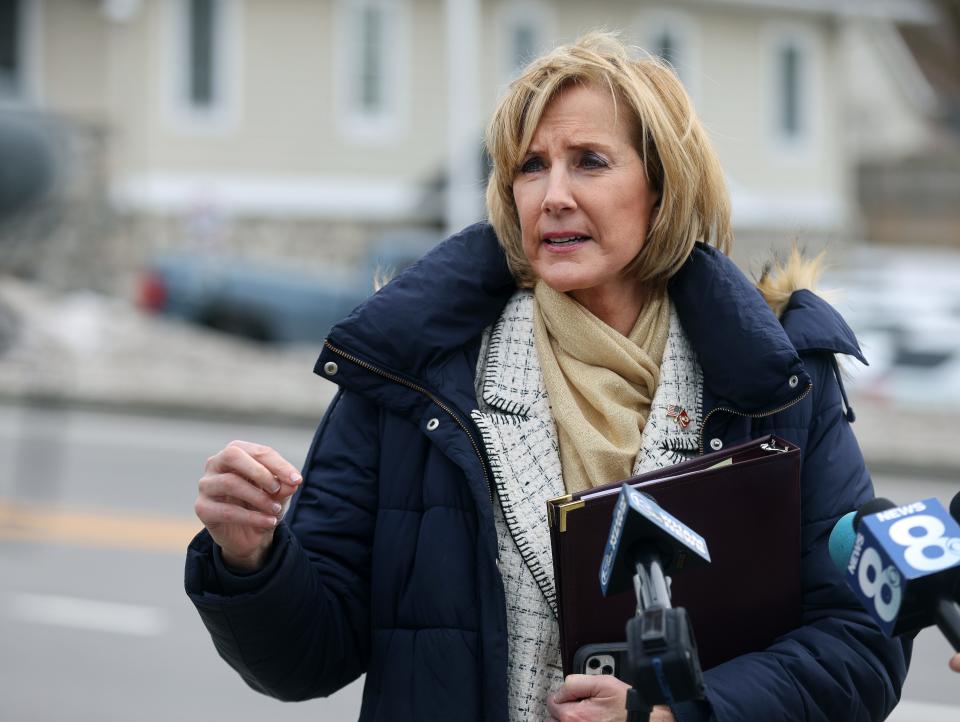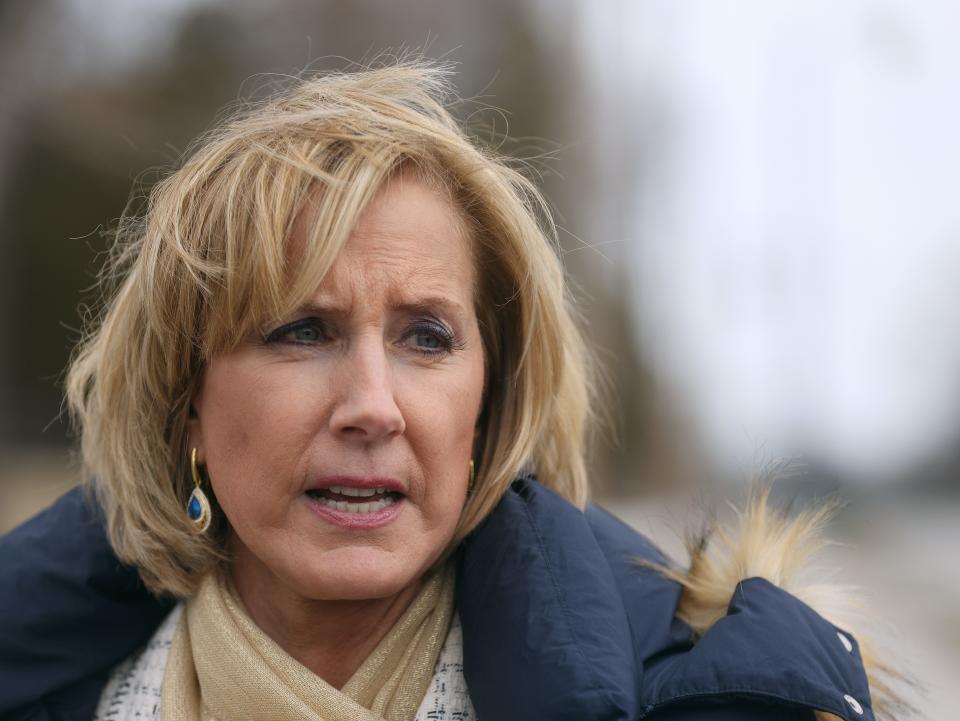Rising immigrant crossings at U.S.-Canada border fuel debate on proper response
- Oops!Something went wrong.Please try again later.
Court documents from recent federal prosecutions offer a glimpse at what border patrol agents have termed “an unprecedented influx of human trafficking” along sections of New York’s northern border.That trend is prompting responses, including from law enforcement, advocates for immigrants and a conservative member of Congress who visited Rochester on Friday to express concerns.
Between October and January, apprehensions of and encounters with persons crossing the border in the vicinity of Swanton, Vermont, jumped nearly 850% compared to the same four months a year ago, according to the U.S. Border Patrol. Many of the immigrants were families with children, according to a recent report in the Burlington Free Press.

U.S. Rep. Claudia Tenney, a Republican representing a Central and Western New York congressional district, visited with U.S. Customs and Border Protection agents in Buffalo and Rochester to discuss the issue.
"The worsening crisis at our Northern border is real," Tenney said. "Our CBP agents face unprecedented challenges because of Joe Biden's failure to address his disastrous open border policies."
On Tuesday, Tenney joined the Northern Border Security Caucus, a coalition of 28 members of Congress concerned about "the increased human and drug trafficking along the U.S.-Canada border."
New York Senate Republican Minority Leader Rob Ortt met with Tenney at the Buffalo Border Patrol office. He complained that "Albany Democrats' soft-on-crime policies have already endangered public safety in our communities."
Advocates for migrants disagree.

Such rhetoric in the U.S., said Meghan Maloney de Zaldivar of Buffalo and the director of organizing and strategy for the New York Immigration Coalition, will hurt sectors such as dairy farming, which is heavily worked by immigrants, that officials such as Tenney purport to represent. Harder-line approaches will also sow more fear and distrust of law enforcement in local communities, she said.
“What we really need is humane and dignified immigration policies,” she said. “That is what Washington should be focusing on.”
Rise in northern border crossings began in mid-2022
U.S. Customs and Border Protection agents began seeing an uptick in illegal crossings along the northern border in June 2022. And the pace has stepped up this winter despite sub-zero temperatures.
Over the four months that ended in January, agents tallied more than 1,500 encounters with people suspected of crossing into the country illegally through the CBP’s Swanton Sector, which stretches from Vermont to New York.
The 367 encounters and apprehensions recorded in January surpassed the 344 logged for the 12 previous Januaries combined, officials say.
Nearly 1,000 of the encounters and apprehensions were with people from Mexico, followed by Haiti and Guatemala. Among the immigrants are parents with young children and infants who must navigate challenging terrain along the border to make it to the U.S. side.
“There are always dangers when attempting to illegally cross the U.S./Canadian border,” a spokesman for the CBP said. “In Swanton Sector, the terrain can be mountainous, heavily wooded and boast multiple rivers, streams and swampland. When you add sub-zero temperatures to that equation, the real risk to human life multiplies dramatically. Hypothermia and loss of life are very real dangers.”
And yet, the surging numbers do not approach the totals seen at the nation’s southern border with Mexico.
In the 2022 fiscal year, federal agents had encounters with 109,000 individuals at the northern border compared to 2.3 million during the same time period at the southern border.
Smugglers are making thousands of dollars to pick up people who, in some cases, fly into Canada from Mexico before making the trek across the border, court documents show.
Around 8 p.m. Sept. 25, 2022, border patrol agents spotted a Toyota Venza driven by a Queens man traveling through Churubusco, an unincorporated hamlet in Clinton County, New York near the New York-Quebec border. The Toyota traveled along Route 189, a popular route for human smugglers because it leads to and from the border.
Two passengers were riding in the backseat while the passenger seat was empty — an indication the driver didn’t know his passengers, according to the criminal complaint. And the windows were fogged on a rainy night, a sign that the people inside had wet clothing, a criminal complaint adds.
Inside a duffel bag belonging to one of the backseat passengers was a ticket for a plane ride from Cancun, Mexico, to Toronto the day before.
One of the men said he’d agreed to pay the driver $2,000 once he got him to his destination in New York.
A few weeks later on Oct. 8, 2022, about 30 miles east in Champlain, New York, agents using remote surveillance observed several people in a wooded area beside a road that dead ends into the New York-Quebec border, a criminal complaint says.
Someone living nearby spotted several people emerge from the woods and get into a Chevy Camaro and an SUV. The cars were stopped about two hours later along Interstate 87 in the town of Plattsburgh.
The driver of the Camaro acknowledged driving to the border to pick up individuals who’d crossed into the U.S. illegally and said he was promised $500 for each person he picked up.
Eleven people were arrested. All claimed to be from Mexico.
The SUV driver said he was promised $3,000 by a smuggler to drive up to the border and deliver several people to Maryland. He knew what he was doing was wrong but “claims he was looking to make easy money,” according to an account provided by a border agent.
Casualties of 'inhumane U.S. policy'
In Burlington, Vermont, the nonprofit Migrant Justice said the reported increases of crossings in the Swanton Sector are an outcome of denying human rights to migrate.
"The draconian restrictions that the U.S. employs against people seeking refuge from violence and poverty only push migrants to more dangerous routes," the nonprofit said in a statement. "Every migrant who dies attempting to enter the U.S. — whether from dehydration in the Sonoran desert, drowning in the Rio Grande, or hypothermia and exposure on the Canadian border — is a casualty of inhumane U.S. policy."
Organizations that assist immigrants settling in Western New York and the North Country said they haven’t seen increases in people requesting services. Instead, many saw Rep. Tenney’s call as rhetoric for hard-line immigration enforcement.
“Absolutely no one” at the Rochester nonprofit Mary’s Place Refugee Outreach has entered through the northern border, Executive Director P.J. Ryan said. Most people enter through the southern border. They are released on parole as they await their immigration cases, he added.
The southern border should be a cautionary tale for politicians, said Jessica Maxwell, the executive director of the Workers Center of Central New York, based in Syracuse but with members in the North Country, which has workers in sectors such as agriculture, sawmills and renewable energy installation.
“These militarization policies on the border have done nothing to stem flows of migration, and certainly have contributed to human rights abuses,” she said.
“It really seems to be a reflection of, unfortunately, some really deep racism against immigrant communities,” she said. “And not a reflection of good, solid policy.”
In Buffalo, Maloney de Zaldivar from the Immigration Coalition said she’s used to seeing “ebbs and flows” of immigrants at the border with Canada, often as a result of southern border policies.
Many immigrants have also made a reverse journey to leave the U.S., which she said could skew American immigration figures.
In light of labor shortages, the Canadian government has promised to accept nearly 1.5 million immigrants by 2025. Numbers have surged of people entering from the country’s border with the U.S., according to the Canada Border Service Agency. The Quebec and Ontario provinces, which border New York, have the largest numbers of people entering.
This article originally appeared on Rochester Democrat and Chronicle: Surge in immigrant crossings at U.S.-Canada border since mid-2022

